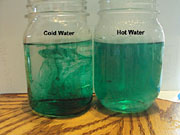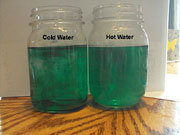Climate Change: Winners and Losers
Lesson 1: The Greenhouse Effect
Page 1 Page 2: Heat Page 3 Page 4 ReviewHeat
What is heat?
Try this experiment.
1) Fill one clear glass with cold water and another clear glass with hot water.
2) Place 1 drop of food coloring in each glass.
3) Observe the two glasses for 2 - 3 minutes. What do you notice?
4) Hold each glass for a moment. Do you notice any difference in the temperature of the two glasses? Which one is warmer?
How quickly did the food coloring work its way through all the water? Was there any difference in how long it took the water in the two glasses to change color?
In case you are unable to do this experiment at home, I've made a web page that shows the Results that I got when I did this. In my test I used ice water for the cold water and heated water on the stove until it was just about boiling for the hot water. My Results may be more dramatic than yours, but as long you used hot and cold water, you should have noticed a difference in how quickly the food coloring spread throughout the water in the two glasses.
In the hot water, it took about 30 seconds for the dye to completely mix with the water:

30 seconds after adding the food coloring.
In the cold water, it took much longer, over 3 minutes before all the water in the glass turned green:

3 minutes after adding the food coloring.
Why did the dye spread out so much faster in the hot water than in the cold? In both glasses, the water particles--the water "molecules"--crash into the dye molecules and bang them all around the glass. They spread the dye around and eventually turn the water green. But the water molecules are moving around much faster in the hot water than in the cold, so it takes less time to spread the dye around evenly in the hot water.
It's not just by chance that molecules in hot water move faster than molecules in cold water--that's what heat is! Heat is the result of the motion of the molecules that make up an object. The faster those molecules move, the warmer that object is. This is true for liquids like water, and also for gases, like the gases that make up our atmosphere. (With solids, the molecules stay in place but vibrate more rapidly as they heat up.)
If you did this experiment, hold the outside of the glass with the cold water for a moment, then hold the glass with the hot water. Can you feel the difference in temperature? The hot water molecules, which are moving faster than the cold, are causing the molecules in the cup to move faster. Another way to think of this is that the hot water is sending some of its heat energy into the cup.
Go to Page 3